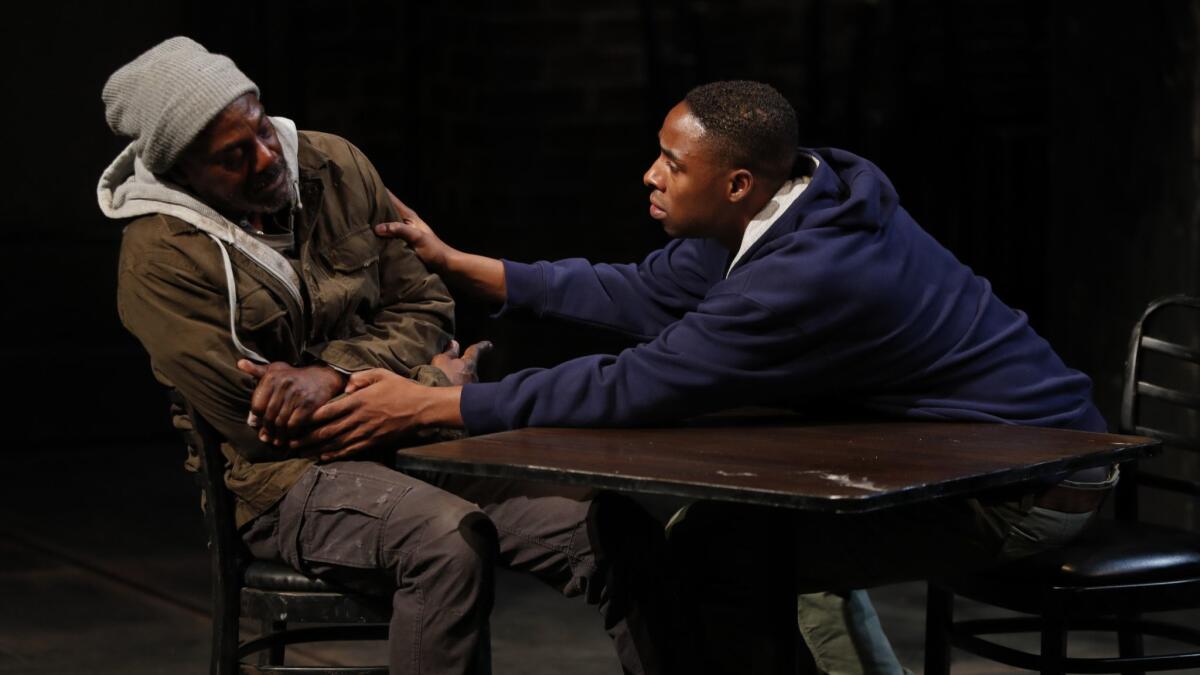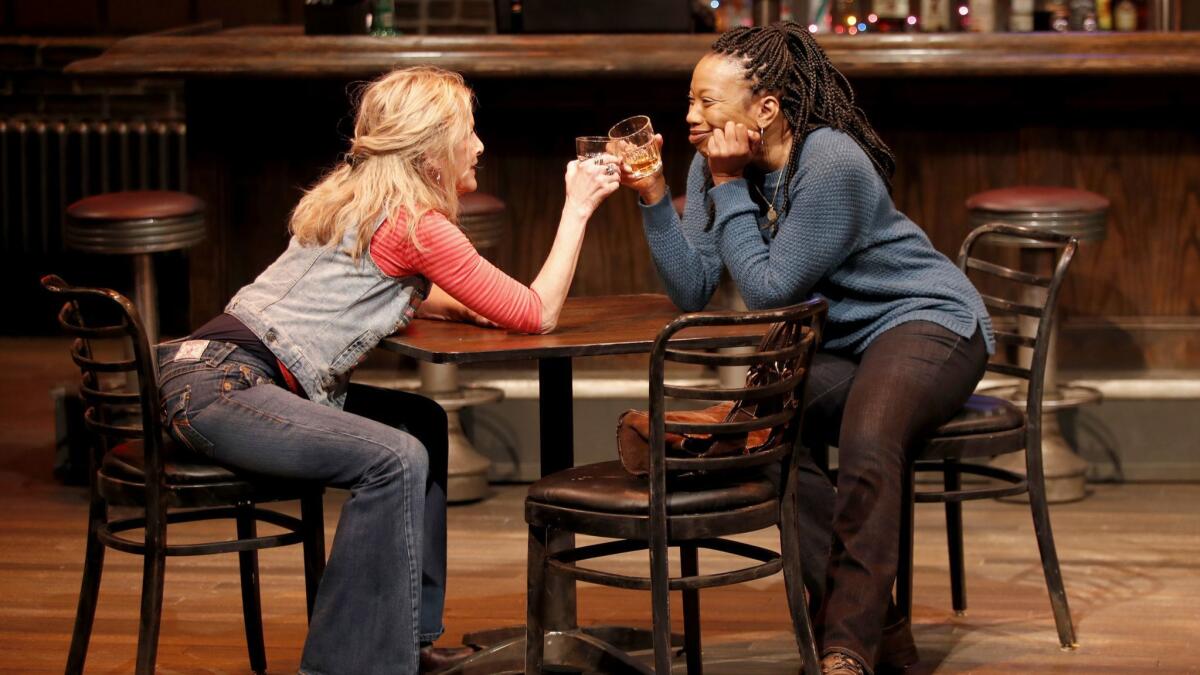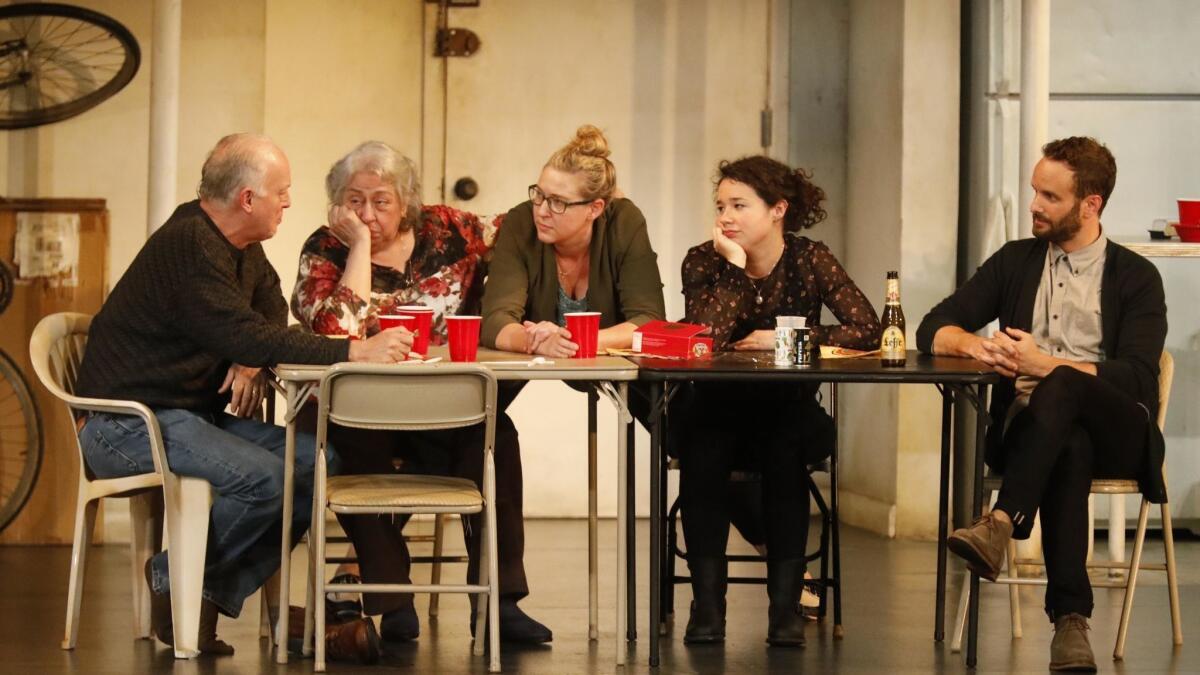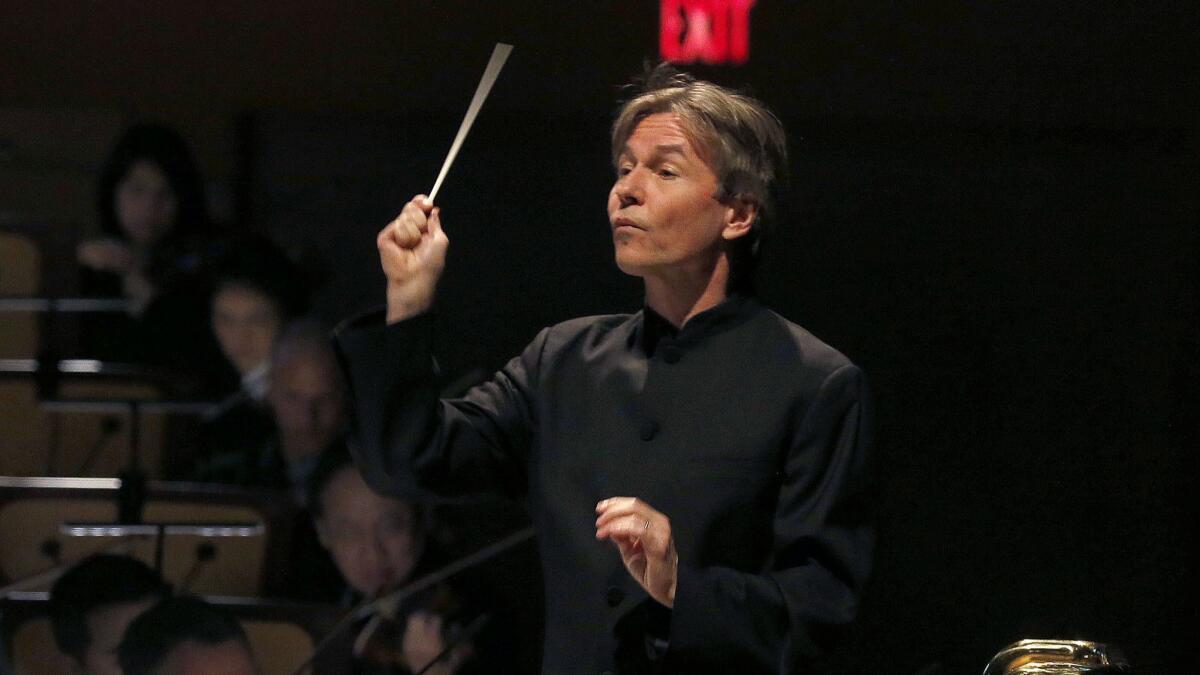Times critics reflect on how the Great Recession affected theater, music and the arts

How have L.A.'s cultural institutions and arts community endured in the decade since the 2008 financial meltdown? It’s been a period of great institutional abundance, growing cultural confidence, and a staggering cost of living, especially for the artists who make it all happen. When historians look back at Los Angeles cultural landscape in the years after the Great Recession they’ll find a strange mix of obstacles and successes. Below Times critics Charles McNulty, Christopher Knight and Mark Swed explore how the economic collapse of 2008 affected the cultural landscape of today.
10 years after the Great Recession, American playwriting thrives, but obstacles for local theaters still linger

“Don’tcha think it should cost less to be alive?”
This line from Stephen Karam’s drama “The Humans,” which won the Tony Award for best play in 2016, gives voice to the economic insecurity that has not only roiled American lives but also reshaped American playwriting since the Great Recession hit 10 years ago.
Money has always been a point of interest in our theater. But when the subject was raised on our most prominent stages in recent decades, it typically occurred in enviable apartments and genteel country homes. The cramped domestic spaces in Arthur Miller’s Brooklyn and Clifford Odets’ Bronx fell out of favor as the Great Depression faded from memory.
One could be forgiven for assuming that during the real estate bubble years, scenic designers were professionally mandated to stoke house envy. The crash changed all that. Even on Broadway, where the average household income of theatergoers is more than $200,000, the anger and anxiety of the battered middle class are taking center stage.
Lynn Nottage’s Pulitzer Prize-winning “Sweat,” set in a declining Pennsylvania factory town, dramatizes the plight of industrial workers, who realize “just like that, one day life is good, the next you’re treading water.” Ayad Akhtar’s “Junk,” a brainy play about the financial industry, traces back to that moment when greed replaced value as the engine of our economy.
It’s hard to imagine either of these works receiving Broadway productions before the fall of Lehman Brothers, the storied investment bank that went bust during the subprime mortgage crisis. That theatrically unpropitious tale, not incidentally, has been stirringly captured in “The Lehman Trilogy,” a heralded European play headed to New York this spring.
"The anger and anxiety of the battered middle class are taking center stage."
If the Great Recession inadvertently broadened the scope of contemporary drama, its effect on our local theaters has been less salubrious. The arts in America are perpetually in an economic downturn, so it’s not possible to attribute all the weakness in our theater ecology to one seismic slump.
What can be said with confidence is that certain deleterious trends were exacerbated by the bursting of the housing bubble. The commercialization of the nonprofit theater was already underway, but the reliance on salacious box office bait has only intensified since 2008.
Artistic directors groping for a respectable path forward talk about the need to create “events” in an environment in which people are already anxious about how much they’re spending on home entertainment options. When your workplace has gone through a decade of downsizing, disposable income no long seems all that disposable.

More and more theatergoers need a guarantee that the time and money lavished on cultural luxuries will be well-spent. If this sentiment misunderstands the place of the arts in civic life, theater leaders have only themselves to blame for treating patrons like customers and for counting dynamic pricing and Facebook ads as key innovative strategies of the protracted recovery period.
L.A.’s theater landscape has long been divided between the haves and the have-nots. Robust midsize venues, mirroring the travails of today’s middle class, have struggled to gain a foothold in the city. But behemoths like Center Theatre Group now have something in common with their scrappy 99-seat cousins: Both are desperate to win back audience loyalty, recognizing that no business plan can succeed in the long term without this basic trust.
My advice in moving forward: Follow the playwrights, not the easy money. This new generation of American dramatists is more diverse than ever, and these writers are speaking directly to theatergoers who haven’t always felt that the stage took much interest in their lives.
Playwrights like Dominique Morisseau, Samuel D. Hunter and Quiara Alegría Hudes are not afraid to talk about rent, student loans and the medical bills that are never out of mind in an America that has lost faith in the middle-class dream. “Cost of Living,” the title of Martyna Majok’s 2018 Pulitzer Prize-winning play now at the Fountain Theatre, is no longer an afterthought but a main topic of concern onstage and off.
How the Great Recession spread the idea that art could be an asset class

How did the Great Recession happen?
Books have been written analyzing the complex causes of America’s financial slide in December 2007, culminating the next year in the most severe economic downturn since the Great Depression. Real estate collapse, steep drops in mortgage securities, Wall Street bankruptcies, rot in inexplicable financial derivatives that even their creators, so-called Masters of the Universe, could not explain – the ruination was vast. Global recession soon followed.
The contemporary art market didn’t much mind. In fact, it could be argued (and I will) that the Great Recession had a significant role to play in cementing the idea that contemporary art could be an asset class, like stocks, bonds, equities or money markets.
Once, that was a minority view. Today it’s common.
A survey in the Deloitte 2017 Art & Finance Report indicated that nine out of 10 wealth managers now believe art and collectibles should be included in large portfolios. Wealth needs to be parked somewhere, and with real estate temporarily on the skids, historically low interest rates and expanded popular interest in art, the prospect of transforming ink printed on paper — otherwise known as cash — into paint freshly slathered on canvas only became more commonplace among ultra-high-worth moneybags.
This has in turn fostered a boom in the art advisor business, bankers themselves not being necessarily adept in maneuvering in the art world snake pit. The boom has narrowed the field of asset-class artists, since supply is virtually unlimited, but demand is far from it. Buying just any old thing won’t work.
This has led to marvelous nonsense. I’m not an art market specialist — I find the topic mostly boring, since mercenary values are unrelated to artistic principles — but it can certainly be amusing to see what investment-minded art buyers do.
Late last month, an anonymous investor dropped $432,500 at a Christie’s auction of what was dubbed the first major sale of Artificial Intelligence art — oil paint on canvas delivered through a digital platform created by a trio of French computer programming geeks. A data set of 15,000 portraits painted between the 14th century and the 20th century was fed into the system, and out popped a blurry smoosh that got named “Portrait of Edmond Belamy.”
The name Belamy roughly means “Nice friend.”
He should have been named Al Gorithm, since that is the smoosh’s parentage. As a writer at Vox smartly noted, the portrait represents the difference between a natural diamond and one grown in a lab.
To which I would add: Art with no artist involved is otherwise known as hobby craft. And natural diamonds are not even in short supply.
"Art with no artist involved is otherwise known as hobby craft."
Talk about artificial intelligence. “Portrait of Edmond Belamy” wouldn’t survive as student work in a rigorous art school crit. I think this is the “collectibles” end of the spread that Deloitte was referring to, something along the lines of an “Avengers” movie poster signed by the entire cast, or the fossilized tooth of an extinct species of shark. Tagging something “AI art” adds cutting-edge pretension, which apparently has a premium attached.
This sort of folderol hovers around at the high end, where a largely meaningless collectible already aggressively estimated to fetch $7,000 can get secretively hammered down at 60 times the price. That’s an economic region where art-world Masters of the Universe play.
More soberly, the ultra-wealthy also keep top-tier art galleries afloat — legitimate places with multicity outlets like Gagosian in Beverly Hills, Blum & Poe in Culver City, Matthew Marks in West Hollywood or Hauser & Wirth downtown. What’s worrisome about the asset class phenomenon — especially when it plays out as public spectacle in the social milieu of an art fair — is the pressure it applies downward to lower tiers.
Not the small shoestring galleries, which come and go and provide a welcome measure of liveliness through the constant exposure afforded to untried artists, but the established, midrange ones. Commercially, the midlevel has always been the most difficult business to sustain, but it is the arena in which many artists are tested for the long-haul. The Great Recession, which hit the middle class hard and rattled the rich, was instrumental in chilling that.
Some notable economists expect another financial crisis to arrive in the next year or two. If so, those galleries would seem to be most vulnerable.
Success for classical music was forged by ambition

On Oct. 2, 2008, a few weeks after Lehman Brothers collapsed, Esa-Pekka Salonen told the audience assembled in Walt Disney Concert Hall for the Los Angeles Philharmonic’s opening night gala that “any connection between the proceedings and the real world was purely coincidental.”
It was the beginning of his final season as music director, and the orchestra went all out for him. The gala ended with Salonen conducting the suite to Stravinsky’s “Firebird,” and to the utter astonishment of all, fireworks — real fireworks! — were set off inside the hall.
Then again, the classical music scene looked optimistically flush hereabouts. The September financial crisis came just as an aspiring Los Angeles Opera was opening its season with Woody Allen’s production of “Gianni Schicchi,” premiering Howard Shore’s “The Fly,” mounting Robert Wilson’s exquisite “Madama Butterfly” and making final preparations for its upcoming “Ring” cycle.
The Broad Stage opened that month, bringing a major new performing arts venue to Santa Monica. The 2-year-old Renée and Henry Segerstrom Concert Hall in Costa Mesa inaugurated its grand organ. Los Angeles Chamber Orchestra had a grand occasion celebrating its first music director, Neville Marriner.
"What matters in the end is not money but priorities."
What’s changed and why? Thankfully, everyone is still in business. The L.A. Phil is taking over the world. L.A. Opera has tightened its belt, but the company is looking good with its sensational production of Philip Glass’ “Satyagraha” and the eagerly awaited world premiere next month of Ellen Reid’s “Prism.” The Broad Stage has lost some of its moxie, but its new Beverly Hills neighbor, the Wallis Annenberg Center for the Performing Arts, is picking up the slack. Segerstrom hums along. LACO spent the decade getting more important with each passing year.
Tough times are not always bad times, and so many factors are involved in the evolution of the arts that cause and effect are simply not quantifiable. Technology. Entrepreneurship. Audiences. The economy. You name it. All play ever-changing parts. Institutions die and new ones are born. Look around downtown L.A. and elsewhere. Young musicians have begun their own ensembles. To be an outlier is to be in. Composers have found the players they need. New music and new opera are thriving throughout the country like never before.
What matters in the end is not money but priorities. If a lesson from the last decade is to be learned, let it be the two most extreme cases: the rise of the Los Angeles Philharmonic and the fall of New York City Opera.
The economy tanked just as City Opera was about to embark on a grand adventure. The world’s most successfully progressive opera impresario, Gerard Mortier, had been hired to revolutionize opera in New York. His plan was to renovate the company’s home in Lincoln Center, mount and commission major new works and neglected modern masterpieces, enliven productions and court controversy.
He didn’t get very far. His budget was slashed almost in half just as he was about to embark on his first season in 2009. He quit. Instead of risking everything on Mortier’s vision, with the idea that it would create enough excitement to raise the shortfall, the board played it safe. The company instead became increasingly negligible and eventually went under. Mortier headed to Madrid, where money was tight and the audience conservative. He refused to economize and did wonders up until his death four years ago.
The L.A. Phil stands as the role model. The orchestra let nothing stand in its way as it celebrated Salonen and, in 2009, welcomed Gustavo Dudamel with uncompromising ambitions. The institution spent money like it was going out of style on Dudamel’s education projects and artistic dreams of gigantic symphonic cycles and expensive opera productions.
And exactly what Mortier said would happen (and I’m convinced would have happened) did in L.A. The orchestra’s president and chief executive, Deborah Borda, put her faith in genius. The visions of Salonen and Dudamel came first. Money followed from a circle of committed donors who recognized that they could make a meaningful and lasting difference to art and to the community.
Just look around today, and you know the outcome.
[email protected], [email protected], [email protected]
Twitter: @KnightLAT, @charlesmcnulty
The biggest entertainment stories
Get our big stories about Hollywood, film, television, music, arts, culture and more right in your inbox as soon as they publish.
You may occasionally receive promotional content from the Los Angeles Times.










